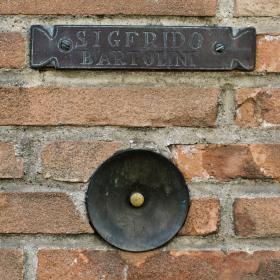A Casa della Vita... and Beyond – The Sigfrido Bartolini House & Museum - Pistoia
The Sigfrido Bartolini House (Via di Bigiano 5, Pistoia) presents a mirror of this superlative, eclectic, and original artist who in his turn mirrored and moulded the cultural environment of the recently-concluded century. This was the family home but first and foremost the studio and workshop for his many, varied activities. In his unpublished diary Disperata Felicità (‘Desperate Happiness’ -1954-2007), the artist himself writes: My home is like one of my paintings; I know it brushstroke by brushstroke.
The house became a Museum shortly after the artist’s death, allowing us to enter his world and that of Pinocchio, where the fairy-tale, illustrated by him in 309 black-and-white and coloured xylographies, mixes with concrete reality in the form of the artist’s instruments: the chisels and gravers for wood-engraving; the work-bench with the wooden planks, printer's proofs, rollers, etc.; the model of the wooden puppet which he built, like Geppetto, in order to draw it; the objects which he depicted in the book to re-create the fantastic but very real world of Collodi’s Tuscany; the press for copperplate-engraving (designed and constructed by the artist himself in the fifties) and lithography; the stencils, in wood for wood-engravings, in zinc for etchings, and in stone for lithographs.
A studio-workshop in which the non-specialist too can perceive how an illustrated book is born, its technical and expressive stages, and the final result, documented by specially-compiled synoptic tables, and also by a video, shot in the eighties for television and then recorded, in which the artist himself explains eloquently and engagingly the whole engraving-to-print process.
The collection of paintings on the walls of the House is an intriguing and largely new itinerary through the artist’s works: from large, detached Frescoes to the series of fascinating Monotypes, from Xylographies (of different sizes, from 2 cm. to 200) and their related Stencils, to Oils (from 1945 to 2006), while also presenting the work of like-minded twentieth-century artists, from maestri such as Soffici, Sironi, De Chirico, Viani, Maccari, Costetti, Nannini, Michelucci, and others, to artists of the Pistoia School who may be less-known to the general public but each possessing his particular excellence: Bugiani, Agostini, Cappellini, Innocenti, etc.. In short, the visitor is offered an original and fascinating permanent exhibition with nothing of the cold context of a museum display.
Every room on the three levels of the house on Via Bigiano 5 is redolent of Sigfrido Bartolini. Arranged throughout the house are the Plaster Moulds (life-size) of Venus de Milo, the Aphrodite of Cyrene, and the Parthenon Frieze, attesting to his debt to classical antiquity; the collection of amphorae, coming from the various Italian regions, the Tuscan pitchers of different typologies and sizes, and the objects, now mostly obsolete, of folk tradition bear witness to his admiration for the cultures of manual dexterity.
The well-furnished Library, divided between the ground-floor and the attic, documents both the artist’s intellectual development and his vocation as art critic and scholar.
The Archive and Twentieth-century Magazine Collection offer both the curious visitor and the scholar a panorama and supporting records of that part of twentieth century Bartolini had a part in forming.
Not only, then, a house and museum, but a living, breathing, “moving” and “magic” artist’s house, in the words of those who know it, to discover room by room, for the arrangement, invention, and realization of an idiosyncratic environment created by Bartolini and linked, in whole and in its constituent parts, to an inventiveness which was simple yet eccentric, cultured yet demotic.
A interview with the artist, filmed at the Anthological Exhibition organized by the Lombardy Regional Council at the MilanTriennale, reveals all Bartolini’s verve, spontaneity, and Tuscan shrewdness.
Also on display are the 14 Modern Stained-glass Windows of Lead-bound Glass Tesserae (7 Works of Mercy and the 7 Sacraments) which he created in 2005 for the Church of the Immacolata, some 200 metres from what is now his house and museum; they were to be the last large-scale project before his death.
